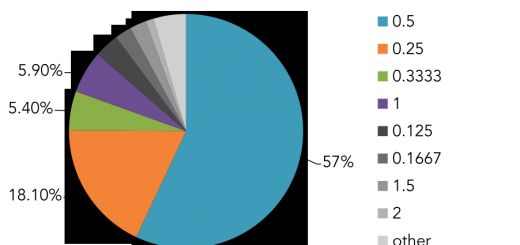Featured Recording | Beyoncé (2013)
In this thought piece, Alexandra Apolloni reflects on Beyoncé’s newest album, Beyoncé. Given the unique release of the “visual album” on YouTube, Apolloni considers the album through the lens of Carol Vernallis’ work in Unruly Media, which she reviewed for Echo in Volume 12.1.
***
Carol Vernallis’ Unruly Media provides a primer for understanding how sound and visuals work together in our current media climate. The timing of its publication was fortuitous: in December 2013, a few months following the publication of Unruly Media, Beyoncé Knowles surprised fans with the unexpected release of her “visual album,” Beyoncé. Beyoncé is, arguably, unruly media at its unruliest. With an initial online-only release, and a video to accompany each of its 17 tracks, Beyoncé challenges industry notions of what an album is, how a record is marketed, and confirmed that, at a moment when pop music is frequently consumed through videos, sound and visuals are inexorably partnered in creating musical meaning. Beyoncé eludes formal designations: is it a series of unconnected videos? Does it have a narrative, like a film? Meanwhile, its visual and sonic worlds are elaborate, intense, and often overwhelming. After watching it I’m left wondering just what it is that I’ve experienced. Vernallis’ work in Unruly Media provides a set of tools for understanding new media like Beyoncé.
My first experience of Beyoncé was of watching the album all the way through. There’s a level on which it works if you view it this way, as a film: while the songs are each quite singular and unique, Knowles’ voice works like a throughline and a guide, suggesting a narrative thread connecting the images in each video. Like the “post-classical” films of Unruly Media, Beyoncé doesn’t have one clear, coherent narrative. Instead, as in the films Vernallis discusses, like Eternal Sunshine of the Spotless Mind, sound and image suggest multiple narrative possibilities. In Beyoncé, moments of conflict and loss propel us to moments of transcendence: Knowles’ low, repetitive and melodically stagnant singing in the verses of “Mine,” for instance, makes way for the euphoria suggested by her lullaby-like vocals in “Blue.” There’s a strong autobiographical thread: images and people from Knowles’ past and present appear, hinting that this is a story about Knowles; but, given the surreal and fantastical imagery that also recurs throughout, the album skirts the edges of reality, and eludes straightforward biography. Just as Vernallis’ post-classical films often feature striking visual objects that connect to sounds and suggest meaning, visual objects recur in Beyoncé, suggesting narrative – the trophy from “Pretty Hurts,” for instance, reappears at the beginning of “Drunk in Love” – but the meanings of these objects aren’t made clear.
The incoherence of Beyoncé’s narrative is, I think, part of why feminist commentators have found it so elusive and difficult. At some moments it preaches feminist empowerment, at others it seems to contradict that message: the body positive words of “Pretty Hurts,” for instance, seem at odds with the kind of sexual subjugation that some might hear in “Partition.” Others might read “Partition” as locating power in sexual pleasure, and in the ability to navigate different roles and power relationships. Taken as a whole, as a complete work, Beyoncé’s inconsistencies and consistencies, as communicated through a combination of audio and visuals, might be the most effective way of telling a story about contemporary feminism, black womanhood, and celebrity culture, given that stable positions and identities no longer seem to stick. It’s a new feminist narrative, in the mode of the new digital cinema.
The individual music videos that comprise Beyoncé have a visual style drawn from what Vernallis calls the YouTube aesthetic: they look like they’re made for consumption on small screens, and made for sharing online. I think of the flowing fabric motifs in the video for “Mine,” which create striking visual lines that translate clearly on a mobile device, and I think of the jerky hand motions from the dance sequence in “Flawless”: they seem made explicitly to be translated into an animated GIF, a tiny audiovisual moment that seems constructed to be an instant meme.
Vernallis argues that YouTube has enabled videos to become edgier than ever before, as the pressure of appealing to broadcast standards no longer applies. In Beyoncé,there are also moments of surprising darkness: when Beyoncé bears her teeth in “Flawless,” when we get fleeting horror movie-style images in “Haunted,” when “Yonce” and “Partition” craft a story of sexual power through shadowy silhouettes and dissonant trap beats. It’s hard to imagine these moments appearing on television, even ten years ago.
Finally, Vernallis argues that digital media, and specifically, YouTube, enable new relationships with the past, as video clips are resurrected and given new context and meaning. Beyoncé also reanimates moments of the past. It recreates a 1970s roller disco in “Blow,” takes us through a series of reconstructed home movies in “Grown Woman,” brings us back to Knowles’ early years appearing on Star Search as a member of the group Girls’ Tyme. The album moves backward and forward through time and defies cause and effect. Sonically, too, the album moves swiftly through different worlds: from slow jams to confrontational dissonance without a breath. While one way of watching Beyoncé might be to see it as a film, another might be to see it as mimicking the experience of watching music videos on YouTube: drifting from one to the next via common threads or search terms, experiencing different images, sounds, without clear direction.
Vernallis’ Unruly Media is a compelling guidebook for navigating works like Beyoncé. Beyoncé itself is a guidebook, too – a guidebook to experiencing new media and new feminisms.
***
Alexandra Apolloni holds a PhD in Musicology from UCLA. She is currently a Research Scholar at the UCLA Center for the Study of Women, and teaches in the UCLA Music Industry program. Her current book project explores questions of voice, race, and gender in performances by girl singers in 1960s Britain.



